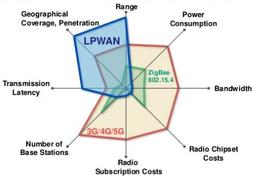
LiFi Physical Layer Basics: PHY-I, PHY-II, and PHY-III Types
Explore the LiFi physical layer (PHY), including PHY-I, PHY-II, and PHY-III versions, their features, modulation, and code rates for different data rate needs.
Advertisement

Explore the LiFi physical layer (PHY), including PHY-I, PHY-II, and PHY-III versions, their features, modulation, and code rates for different data rate needs.

Explore LiFi technology: its protocol layers, how it works, and its applications. Learn about this high-speed, secure wireless communication method using visible light.

Explore LMDS and MMDS technologies for wireless broadband, including their architectures, advantages, disadvantages, and a detailed comparison.
Understand the key differences between local and global variables in LabVIEW, including how to create and use them for data sharing within and between VIs.

Explore a comprehensive list of LoRa channels, mapping frequency to channel number. Optimize your LoRa devices by understanding these settings.
Explore LoRa frequency bands for Europe, US, UK, and Australia. Understand regional differences in spectrum allocation for optimal IoT network performance.

Explore the LoRa physical layer (PHY), its functions, and key message formats. Learn how LoRa's PHY ensures robust, long-range, low-power communication in IoT.

Explore LoRa technology: frame structure, LoRaWAN architecture with gateways and end devices, and the protocol stack layers for effective IoT network design.

Explore the LoRaWAN architecture, including end devices, gateways, network servers, and application servers, highlighting their roles in IoT data transfer.

Learn about LPWAN (Low Power Wide Area Network) technology, its architecture, key features, and benefits for IoT and M2M applications.

Navigate LTE documents on the 3GPP website with this helpful traceability matrix and download guide.

Learn the LTE cell search procedure used by User Equipment (UE) to synchronize with an LTE cell and detect its Physical Layer Cell ID (PCI).

Understand LTE channel mapping including logical, transport, and physical channels. Learn how data flows through these channels for efficient communication in LTE networks.

Learn about the LTE DL-SCH (Downlink Shared Channel), its physical layer processing, and its role in transmitting data in LTE networks.

Learn about LTE EPC interfaces (SGi, S1, S1u, S3, S4, S5, S6a, S11, S12), their functions, and roles in connecting network elements for data transfer and mobility.

Understand the LTE EPS Mobility Management (EMM) states: EMM-Deregistered and EMM-Registered, their transitions, and significance in UE reachability and service availability.

Explore the LTE paging procedure, including the mechanism, call flow diagram, S1AP and RRC messages. Understand how LTE networks efficiently notify idle UEs.

Learn about the LTE PCH (Paging Channel), including the physical layer processing steps for the transmitter, such as CRC, channel coding, and modulation.

Explore the LTE physical layer, focusing on the transmitter modules in both the eNodeB (base station) and UE (user equipment) as per the LTE standard.

Explore the LTE protocol stack's user and control planes. Learn about the functions of each layer (NAS, PDCP, RLC, MAC, PHY, and RF) and their importance in LTE network operations.
Advertisement